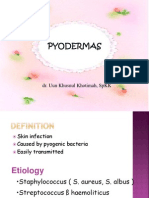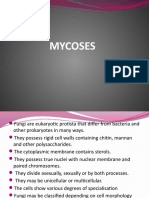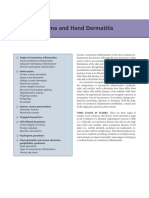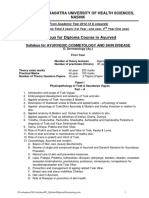integumentary system
integumentary system
Uploaded by
aslamshaista85Copyright:
Available Formats
integumentary system
integumentary system
Uploaded by
aslamshaista85Copyright
Available Formats
Share this document
Did you find this document useful?
Is this content inappropriate?
Copyright:
Available Formats
integumentary system
integumentary system
Uploaded by
aslamshaista85Copyright:
Available Formats
Skin Lesions
Skin lesions are abnormal changes in the skin’s texture, color, or shape and
can be categorized as primary or secondary:
Primary Lesions: Direct results of a disease or condition. Examples include:
Macules: Flat discolorations (e.g., freckles).
Papules: Small, raised bumps (e.g., warts).
Vesicles: Fluid-filled sacs (e.g., blisters).
Pustules: Pus-filled lesions (e.g., acne).
Secondary Lesions: Develop from primary lesions or external factors (e.g.,
infection, scratching). Examples include:
Crusts: Dried blood or pus on the skin.
Ulcers: Open sores due to tissue loss.
Scales: Flaking skin from conditions like psoriasis.
Aging and the Integumentary System
The integumentary system includes the skin, hair, nails, and glands. Aging
affects its structure and function:
Skin Changes:
Thinning of the epidermis and dermis: Skin becomes more fragile and prone
to injury.
Loss of elasticity: Reduced collagen and elastin lead to wrinkles and sagging.
Decreased melanin production: Causes uneven pigmentation and age spots.
Reduced barrier function: Increased risk of infection and dehydration.
Hair and Nail Changes:
Hair grays and thins due to decreased melanin.
Nails grow slower and may become brittle.
Glandular Changes:
Sebaceous glands produce less oil, leading to dry skin.
Sweat glands become less active, impairing temperature regulation.
Signs and Symptoms of Skin Diseases
Common signs and symptoms that may indicate a skin condition include:
Discoloration: Redness, dark spots, or loss of pigmentation (e.g.,
vitiligo).
Texture Changes: Scaliness, roughness, or thickened skin.
Itching or Pain: Common in conditions like eczema, psoriasis, or
shingles.
Lesions or Rashes: May present as bumps, pustules, blisters, or
patches.
Swelling or Inflammation: Often indicates an allergic reaction or
infection.
Cracking or Peeling Skin: Seen in dryness or fungal infections.
Excessive Hair Loss or Growth: May indicate hormonal imbalances or
autoimmune conditions.
Common Examples
Eczema: Red, itchy, dry patches often in the bends of the elbows and knees.
Psoriasis: Thick, silvery scales on the scalp, elbows, or knees.
Acne: Blackheads, whiteheads, or inflamed pustules on the face, chest, or
back.
Shingles: Painful rash with blisters, often on one side of the body.
Skin infections
Bacterial, viral and fungal infections
Impetigo
Definition: A superficial bacterial skin infection caused by
Staphylococcus aureus or Streptococcus pyogenes.
Pathogenesis:
o Bacterial invasion through minor skin breaks.
o Toxin production (e.g., exfoliative toxins in staphylococcal
impetigo).
Morphological Features:
o Intraepidermal pustules.
o Subcorneal vesicles filled with neutrophils.
Clinical Features:
o Honey-colored crusts over erythematous bases, especially on the
face and extremities.
o Contagious and common in children.
Tinea (Dermatophytosis)
Definition: Fungal infection of keratinized tissue caused by
dermatophytes (Trichophyton, Microsporum, Epidermophyton).
Pathogenesis:
o Fungi invade keratinized structures (stratum corneum, nails, and
hair).
o Elicit a mild inflammatory response.
Morphological Features:
o Fungal hyphae in the stratum corneum.
o Hyperkeratosis and mild spongiosis.
Clinical Features:
o Scaly, annular plaques with central clearing ("ringworm")
o Common forms: tinea corporis, tinea capitis, and tinea pedis.
Herpes Simplex Virus (HSV) Infections
Definition: Viral infection of the skin and mucosa caused by HSV-1
(oral) and HSV-2 (genital).
Pathogenesis:
o Virus infects keratinocytes and establishes latency in sensory
ganglia.
o Reactivation occurs due to stress, trauma, or
immunosuppression.
Morphological Features:
o Multinucleated giant cells.
o Intraepidermal vesicles with ballooning degeneration of
keratinocytes.
o Inclusion bodies.
Clinical Features:
o Painful vesicles on erythematous bases.
o Recurrent outbreaks in the same location.
Skin disorders associated with immune system dysfunction
1. Psoriasis
Definition:
A chronic autoimmune skin disorder characterized by rapid epidermal proliferation and
inflammation.
Pathogenesis:
Immune dysregulation: Overactivation of T-helper cells (Th1 and
Th17) leads to cytokine release (e.g., TNF-α, IL-17, IL-23), triggering
keratinocyte hyperproliferation.
Genetic predisposition (HLA-Cw6) and environmental triggers (stress,
infection, trauma).
Morphological Features:
Hyperkeratosis (thickened stratum corneum), parakeratosis (retained
nuclei in stratum corneum), and elongated rete ridges.
Munro microabscesses (neutrophil collections in the stratum corneum)
and spongiform pustules.
Clinical Features:
Well-demarcated, erythematous plaques with silvery scales, commonly
on extensor surfaces.
Associated with nail changes (pitting, onycholysis) and psoriatic
arthritis in some cases.
2. Systemic Lupus Erythematosus (SLE)
Definition:
A multisystem autoimmune disease with skin manifestations due to immune complex deposition.
Pathogenesis:
Autoantibodies (e.g., ANA, anti-dsDNA) form immune complexes
that deposit in skin and other organs, leading to inflammation via
complement activation.
Environmental triggers (UV radiation, infections) exacerbate the
disease in genetically predisposed individuals.
Morphological Features:
Hydropic degeneration of basal keratinocytes.
Thickened basement membrane.
Lymphocytic infiltrates at the dermo-epidermal junction.
Clinical Features:
Acute cutaneous lupus: Malar rash ("butterfly rash") following sun
exposure.
Chronic cutaneous lupus (Discoid lupus): Well-defined, scaly
plaques on the scalp, face, or ears, with scarring and pigment changes.
3. Atopic Dermatitis (Eczema)
Definition:
A chronic inflammatory skin condition characterized by pruritus and eczematous lesions.
Pathogenesis:
Dysregulated immune response with predominance of Th2 cytokines
(IL-4, IL-13) leading to impaired skin barrier (filaggrin gene mutation).
Increased IgE levels and susceptibility to allergens and microbes.
Morphological Features:
Spongiosis (intercellular edema in the epidermis).
Lymphocytic infiltrates in the dermis.
Hyperkeratosis in chronic stages.
Clinical Features:
Pruritic, erythematous, oozing papules and plaques, often on flexural
areas (e.g., antecubital and popliteal fossae).
Associated with allergic rhinitis and asthma (atopic triad).
4. Pemphigus Vulgaris
Definition:
A life-threatening autoimmune blistering disorder caused by loss of intercellular adhesion.
Pathogenesis:
Autoantibodies against desmoglein 1 and 3 in desmosomes disrupt
keratinocyte adhesion (acantholysis).
Often associated with HLA-DR4 and environmental factors (e.g., drugs).
Morphological Features:
Suprabasal acantholysis forming intraepidermal bullae.
Row of tombstone appearance of basal keratinocytes.
Clinical Features:
Flaccid bullae that rupture easily, leaving erosions.
Nikolsky's sign positive (skin shears off with pressure).
Commonly affects mucosa (e.g., oral cavity).
5. Bullous Pemphigoid
Definition:
An autoimmune blistering disorder characterized by subepidermal bullae.
Pathogenesis:
Autoantibodies against hemidesmosomal proteins (BP180 and
BP230) in the basement membrane zone.
Complement activation leads to dermal-epidermal separation.
Morphological Features:
Subepidermal blisters filled with eosinophils and neutrophils.
Linear deposition of IgG and C3 along the basement membrane
(immunofluorescence).
Clinical Features:
Tense, fluid-filled bullae on erythematous or normal skin.
Commonly affects elderly individuals and spares mucosa.
6. Vitiligo
Definition:
An autoimmune disorder causing depigmentation due to melanocyte destruction.
Pathogenesis:
Cytotoxic T-cell-mediated destruction of melanocytes.
Genetic predisposition and environmental triggers (e.g., trauma,
sunburn).
Morphological Features:
Loss of melanocytes in affected areas.
Absence of melanin pigment in histological sections.
Clinical Features:
Well-demarcated depigmented macules and patches, often
symmetrically distributed.
Frequently involves face, hands, and genital areas.
7. Scleroderma (Systemic Sclerosis)
Definition:
A chronic autoimmune disorder characterized by excessive fibrosis of skin and internal organs.
Pathogenesis:
Overproduction of collagen due to fibroblast activation, driven by
cytokines (e.g., TGF-β).
Microvascular damage contributes to ischemia and fibrosis.
Morphological Features:
Dermal fibrosis with loss of adnexal structures.
Thickened collagen bundles.
Clinical Features:
Limited type (CREST syndrome): Calcinosis, Raynaud phenomenon,
Esophageal dysmotility, Sclerodactyly, and Telangiectasia.
Diffuse type: Widespread skin thickening with organ involvement
(lungs, heart, kidneys).
You might also like
- Download Complete Fitzpatrick's Dermatology 9th edition. Edition Sewon Kang PDF for All ChaptersDocument57 pagesDownload Complete Fitzpatrick's Dermatology 9th edition. Edition Sewon Kang PDF for All Chaptersberlysmalese100% (1)
- PASSMED MRCP MCQs-DERMATOLOGY PDFDocument53 pagesPASSMED MRCP MCQs-DERMATOLOGY PDFFatima Ema100% (5)
- Pathology of Integument System: Djoko Legowo, Mkes., DRHDocument135 pagesPathology of Integument System: Djoko Legowo, Mkes., DRHPilar Mitra QurbanNo ratings yet
- Chapter 46Document5 pagesChapter 46unappreciaNo ratings yet
- Skin PathologyDocument23 pagesSkin PathologyeshaarejiNo ratings yet
- Dermatology 1Document47 pagesDermatology 1Edwin OkonNo ratings yet
- SKIN Lecture 2024Document63 pagesSKIN Lecture 2024Vanessa MolotoNo ratings yet
- Inflammatory-Skin-Diseases 231101 174335 (2462)Document37 pagesInflammatory-Skin-Diseases 231101 174335 (2462)Moayad IsmailNo ratings yet
- Ringkasan Common Skin DisorderDocument9 pagesRingkasan Common Skin Disordertwahyuningsih_16No ratings yet
- 16-12-2014 Kuliah Pioderma - Dr. AsihDocument56 pages16-12-2014 Kuliah Pioderma - Dr. AsihSilvia SudjadiNo ratings yet
- 9-Patologi Skin PDFDocument34 pages9-Patologi Skin PDFririnNo ratings yet
- Int. Medicine: Batch 2014-College of MedicineDocument14 pagesInt. Medicine: Batch 2014-College of MedicineGabriel Gerardo N. CortezNo ratings yet
- File 37 - DermaDocument58 pagesFile 37 - Dermanajeeblecture1No ratings yet
- 7-Skin Path.Document89 pages7-Skin Path.Lea MonzerNo ratings yet
- Medical-Surgical Nursing: An Integrated Approach, 2E: Nursing Care of The Client: Integumentary SystemDocument36 pagesMedical-Surgical Nursing: An Integrated Approach, 2E: Nursing Care of The Client: Integumentary Systemtanmai nooluNo ratings yet
- Dr. Igwe DISEASE OF THE SKIN - Doc-1Document11 pagesDr. Igwe DISEASE OF THE SKIN - Doc-1Jake MillerNo ratings yet
- Iinfections and Infestation 2024 Dr. TZADocument120 pagesIinfections and Infestation 2024 Dr. TZAThuzar AungNo ratings yet
- Disorders of Abnormal KeratinizationDocument36 pagesDisorders of Abnormal KeratinizationdayangNo ratings yet
- Skin and Soft Tissue Infection 2024Document43 pagesSkin and Soft Tissue Infection 2024yopiayop7No ratings yet
- Skin Pathology: Ormal Histologic Notes NDocument6 pagesSkin Pathology: Ormal Histologic Notes NEvans chamaNo ratings yet
- Pyodermas 2014Document41 pagesPyodermas 2014Dudy Humaedi100% (6)
- Infection of The Skin, Soft Tissue, Etc.Document84 pagesInfection of The Skin, Soft Tissue, Etc.fmds100% (1)
- Dermatology NotesDocument59 pagesDermatology NotesAbdullah Matar Badran50% (2)
- Inflammatory Skin DiseaseDocument32 pagesInflammatory Skin Diseaseragnarok meroNo ratings yet
- Atopic Dermatitis Eczema NotesDocument12 pagesAtopic Dermatitis Eczema Notes돼끼빈No ratings yet
- General Surgery Copy 2Document37 pagesGeneral Surgery Copy 2sowmyaraja09No ratings yet
- The Pathophysiology of Common Skin DiseasesDocument51 pagesThe Pathophysiology of Common Skin DiseasesLove AtsuNo ratings yet
- Patologia Cutanea Non TumoraleDocument71 pagesPatologia Cutanea Non Tumoralewattyhope004No ratings yet
- Diseases of SkinDocument152 pagesDiseases of SkinSarath ChandraNo ratings yet
- Lobs - PBLDocument19 pagesLobs - PBLAhmad SobihNo ratings yet
- DermatologyDocument95 pagesDermatologyazenrNo ratings yet
- PENDAHULUAN - EfloresensiDocument50 pagesPENDAHULUAN - EfloresensiSucitri NyomanNo ratings yet
- Disorders of Integumentary Function - 2020-2021Document40 pagesDisorders of Integumentary Function - 2020-2021Cres Padua QuinzonNo ratings yet
- Chapter III - Dermatology: Common Skin Conditions and PathologyDocument5 pagesChapter III - Dermatology: Common Skin Conditions and PathologyIndranil SinhaNo ratings yet
- ScienceDocument1 pageScienceni putu.comsurya dianaNo ratings yet
- Hers Hey Chapter 13 RevisedDocument10 pagesHers Hey Chapter 13 RevisedpoddataNo ratings yet
- Acute Inflammatory DermatosesDocument29 pagesAcute Inflammatory DermatosesHaniya KhanNo ratings yet
- Oral Ulceration 2023-2024Document6 pagesOral Ulceration 2023-2024photo copyhemnNo ratings yet
- Lecture Note 2A DISEASES OF THE SKIN AND EYEDocument8 pagesLecture Note 2A DISEASES OF THE SKIN AND EYERAFAELLA SALVE MARIE GAETOSNo ratings yet
- Skin and Its LayersDocument3 pagesSkin and Its Layersumair ahmed RanaNo ratings yet
- Skin and MSK EverythingDocument31 pagesSkin and MSK EverythingBernard HernandezNo ratings yet
- Presentation PhytoDocument57 pagesPresentation Phytoyasmeenelraouf16No ratings yet
- Penyakit Kulit Gawat DaruratDocument15 pagesPenyakit Kulit Gawat DaruratVicky Ilda ViantiniNo ratings yet
- Derma PrintDocument82 pagesDerma PrintthackeryuktaNo ratings yet
- 20 Pathoma Skin DisordersDocument10 pages20 Pathoma Skin Disordersn alawiNo ratings yet
- Kuliah Pioderma DR Asih BudiastutiDocument56 pagesKuliah Pioderma DR Asih BudiastutiunisoldierNo ratings yet
- 2 EczemaDocument5 pages2 Eczemaحسين طاهر حاتم طاهرNo ratings yet
- Skin StructDocument11 pagesSkin StructWidya AstriyaniNo ratings yet
- Dermatology+Review 2015 BATCH SOLVEDDocument7 pagesDermatology+Review 2015 BATCH SOLVEDMati ullah KhanNo ratings yet
- Common SkinDocument15 pagesCommon SkindrakuizNo ratings yet
- Bacterial Skin Infections - Course VIIIDocument37 pagesBacterial Skin Infections - Course VIIIAngelie PedregosaNo ratings yet
- Derma-LmrDocument7 pagesDerma-LmrKannan KannanNo ratings yet
- Skindiseaseppt 180516030333Document70 pagesSkindiseaseppt 180516030333joteetefacNo ratings yet
- Microbial Diseases of The Different Organ System SKINDocument102 pagesMicrobial Diseases of The Different Organ System SKINBea Bianca CruzNo ratings yet
- MYCOSESDocument41 pagesMYCOSESDayana PrasanthNo ratings yet
- Skin Pathology 2Document31 pagesSkin Pathology 2Abdimalik MohametNo ratings yet
- L5 Bacterial Skin InfectionDocument53 pagesL5 Bacterial Skin InfectiongichkimahikanNo ratings yet
- Kuliah SMTR VDocument117 pagesKuliah SMTR VHorakhty PrideNo ratings yet
- Pediatric Disorders of The Integumentary SystemDocument70 pagesPediatric Disorders of The Integumentary SystemJezreel OrquinaNo ratings yet
- Skin DisordersDocument113 pagesSkin DisordersvielesamyzfNo ratings yet
- Infectious Dermatosis (Bacterial Skin Infections)Document31 pagesInfectious Dermatosis (Bacterial Skin Infections)Melch PintacNo ratings yet
- Dermatology Notes for Medical StudentsFrom EverandDermatology Notes for Medical StudentsRating: 4 out of 5 stars4/5 (5)
- thermal injuriesDocument3 pagesthermal injuriesaslamshaista85No ratings yet
- Respiratory System NewDocument26 pagesRespiratory System Newaslamshaista85No ratings yet
- Endocrine PharmacologyDocument8 pagesEndocrine Pharmacologyaslamshaista85No ratings yet
- CVS pptDocument8 pagesCVS pptaslamshaista85No ratings yet
- Eczema: Pathogenesis. Atopic Dermatitis Depends On A Complex Interaction BetweenDocument5 pagesEczema: Pathogenesis. Atopic Dermatitis Depends On A Complex Interaction BetweenSuhas IngaleNo ratings yet
- Case Study IGDocument2 pagesCase Study IGCheha PaikNo ratings yet
- Yaw (Tropical Syphilis)Document16 pagesYaw (Tropical Syphilis)Aiman Tymer100% (1)
- Pruritus and Neurocutaneous DermatosesDocument17 pagesPruritus and Neurocutaneous DermatosesgamhaelNo ratings yet
- Mikosis SuperfisialDocument46 pagesMikosis SuperfisialAdipuraAtmadjaEgokNo ratings yet
- Dermatology TestsDocument6 pagesDermatology TestsLouise Alysson OrtegaNo ratings yet
- Annular LesionsDocument8 pagesAnnular LesionshpmcentreNo ratings yet
- Atopic Eczema: Causes, Incidence, and Risk FactorsDocument5 pagesAtopic Eczema: Causes, Incidence, and Risk FactorsSurenKiddoNo ratings yet
- Physiotherapy in DermatologyDocument18 pagesPhysiotherapy in DermatologyPraisy Roy67% (3)
- Chronic Urticaria Clinical Presentation - History, Physical Examination, ComplicationsDocument5 pagesChronic Urticaria Clinical Presentation - History, Physical Examination, ComplicationsOgy SkillNo ratings yet
- EczemaDocument40 pagesEczemanoyraaryonNo ratings yet
- Dermatitis Numularis PDFDocument3 pagesDermatitis Numularis PDFRiska Permata SariNo ratings yet
- ImpetigoDocument3 pagesImpetigoLauraNo ratings yet
- Spitz Nevi Dan Nodular MelanomaDocument5 pagesSpitz Nevi Dan Nodular MelanomaMeta SakinaNo ratings yet
- 膚科Document191 pages膚科Sai TaiNo ratings yet
- HGDocument7 pagesHGRuchi HumaneNo ratings yet
- FMGE Dermatology Sprint by DR Jazeer (PW MedEd)Document53 pagesFMGE Dermatology Sprint by DR Jazeer (PW MedEd)Stella ParkerNo ratings yet
- Dermoscopic Feature of Chondroid Syringoma: About 2 CasesDocument5 pagesDermoscopic Feature of Chondroid Syringoma: About 2 CasesIJAR JOURNALNo ratings yet
- Derm StuffDocument7 pagesDerm StuffSudesna Roy ChowdhuryNo ratings yet
- Malignant MelanomaDocument16 pagesMalignant MelanomaAshish SNo ratings yet
- 9.allergic and Immunologic DiseasesDocument20 pages9.allergic and Immunologic DiseasesdrpnnreddyNo ratings yet
- Superficial and Cutaneous MycosesDocument36 pagesSuperficial and Cutaneous MycosesMich BagamanoNo ratings yet
- Pics MCQSDocument22 pagesPics MCQStania100% (2)
- Srinadh Neonatal Skin Conditions FinalDocument110 pagesSrinadh Neonatal Skin Conditions FinalSrinadh Pragada100% (1)
- Fitzpatrick SLEDocument41 pagesFitzpatrick SLEIrene DjuardiNo ratings yet
- Weedon s Skin Pathology Expert Consult Online and Print third Edition David Weedon Ao Md Frcpa Fcap(Hon) 2024 scribd downloadDocument85 pagesWeedon s Skin Pathology Expert Consult Online and Print third Edition David Weedon Ao Md Frcpa Fcap(Hon) 2024 scribd downloadbrattizanny100% (8)
- Absolute Dermatology Review - Mastering Clinical Conditions On The Dermatology Recertification Exam (PDFDrive)Document461 pagesAbsolute Dermatology Review - Mastering Clinical Conditions On The Dermatology Recertification Exam (PDFDrive)mogoscristina100% (1)
- Summary of Sem 7 Dermatology: Bacterial InfectionsDocument5 pagesSummary of Sem 7 Dermatology: Bacterial InfectionsHo Yong WaiNo ratings yet





























































































